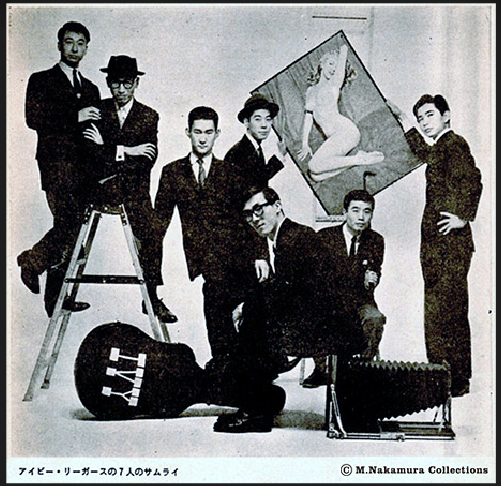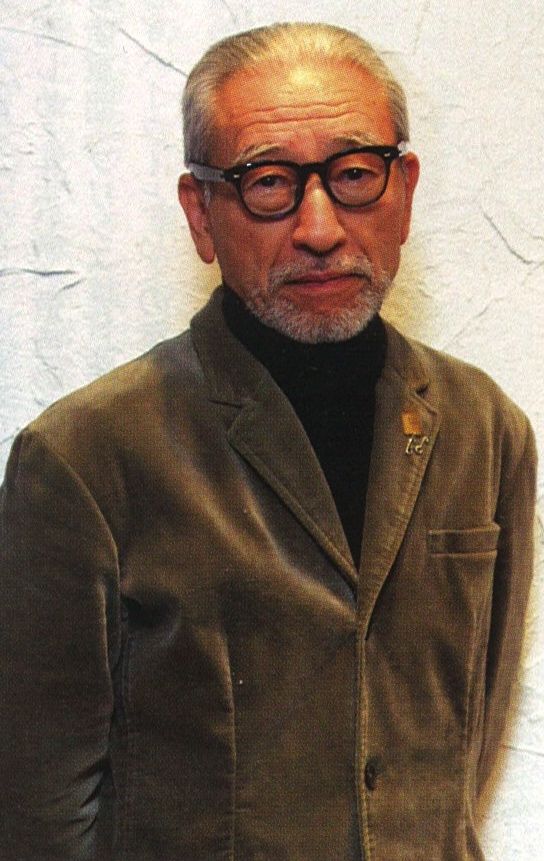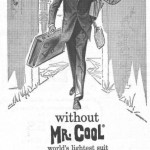
W. David Marx did this interview for Ivy Style back in 2013 while researching his groundbreaking book “Ametora: How Japan Saved American Style.” As part of the research he sat down with Toshiyuki Kurosu (pictured above second from left) at the Kamakura Shirts office in Tokyo. Kurosu is legendary in Japan as one of the very first people to ever discover and wear Ivy League clothing. After joining brand VAN in 1961 at age 24, he convinced his boss Ishizu Kensuke to re-focus the whole company on Ivy style, a risky move that eventually brought the company incredible success, fame, and fortune. And as both a VAN employee and a writer for Men’s Club, Kurosu later became part of the team who created the legendary photo book “Take Ivy.”
* * *
IS: How did you discover Ivy League style in Japan?
TK: The first time I saw the word “Ivy” was Spring 1954 in the very first issue of magazine Otoko no Fukushoku (later renamed Men’s Club). In the issue, there was a glossary of menswear terms, organized by A-to-Z, and there was an entry for “Ivy League style” that read “In America, Ivy is very popular among college students.” That’s all that was written, but I was intrigued. I thought, that’s probably something I would like.
I then realized that I had seen African-American soldiers wearing clothes like that out at the Tachikawa Airfield where I would play in jazz bands. These guys were incredibly stylish. This was the middle of the Korean War, so there were a lot of aircraft coming in and out of Tachikawa. Everyone had money, and there were a lot of suit tailors, shirt-makers, and shoe places located near the camp. My friends and I all loved America, so we’d go out to the clothing stores near the camp, and say, make us what those guys are wearing.
At the time Japanese tailors didn’t know anything about Ivy style. They couldn’t do a “natural shoulder,” so you’d end up with these huge pads. When I made my first Ivy suit at a normal tailor, they just put a third button on top of the normal two-buttons. The silhouette wasn’t Ivy or anything — it was just weird. But I of course wore it thinking it was great.
IS: What was so appealing about Ivy style to you?
TK: It was just the total opposite of Japanese fashion at the time. All the hip musicians wore one-button suit jackets with huge shoulders. I couldn’t even understand the Ivy look as fashion — it was too different. When I started wearing Ivy clothing, people would say, you look like a mayor of a small town in the countryside. That was the image. But that’s what made it fun. I didn’t like it because it was new, but because it was strange. The other people to get into Ivy early in Japan were mostly art school students.
IS: Was the first men’s fashion magazine Men’s Club the biggest influence on your style choices?
TK: Men’s Club was influential, but more than that, jazz was a huge influence. I personally loved jazz, and I played in a jazz band. There were no fashion books from the U.S. in Japan at the time, and we couldn’t really buy issues of GQ or Esquire. So we would look at the LP covers of jazz records and study the clothes of the musicians. We tried to imitate them.
IS: In your book “The Ivy Era” (Aibii no jidai), you wrote that you asked a tailor to make you a button-down shirt but he couldn’t make it correctly.
TK: Yes, it was all wrong. He just cut it like a long-sleeve Hawaiian shirt and put two buttons on the collar. That was the best we could do for “button-down” in that era. I didn’t know what a real one looked like. I proudly wore it for about a year but once I figured out what a real one looked like, I was so embarrassed that I threw it away.
IS: What was so appealing about American fashion at the time compared to European fashion?
TK: At the time American goods were the best — to my friends and I at least. We listened to American jazz, drank coca cola, wore Ivy. America was the coolest at the time. There was nothing really from England.
IS: Once you joined VAN and started manufacturing more authentic Ivy League styled-clothing, what was the early reaction from established clothing retailers?
TK: The more progressive department stores were very quick to stock VAN. If the buyer got what we were doing, they’d stock us. But a lot of time in the early days, I’d send some VAN clothes to the buyers at more conservative department stores, and they’d say, there’s no way this is going to sell, and they’d just send all the clothing back. They’d look at our blazer and say, take all these gold buttons off! There were a lot of gruff guys like that. They were like that about button-down shirts too, This pattern is good but these buttons on the collar just get in the way. Take them off and we’ll buy them.
That all changed with the Tokyo Olympics though. The Japan team wore red blazers with gold buttons, which was the idea of VAN founder Ishizu Kensuke. That made blazers acceptable in society, so suddenly the buyers were like, oh this blazer is great, please send some over quickly.
IS: Why do you think VAN was such a success?
TK: VAN would basically create things that never existed before or things that were common in the U.S. but not available in Japan. We would just copy those American goods, and they all sold like crazy. But no one realized that this is what we were doing.
Take T-shirts, for example. We tried to quietly put them in stores, but no one bought them. So then we would write in Men’s Club or wherever, “All American students wear T-shirts!” and suddenly everyone would buy them.
 IS: Where did the idea for “Take Ivy” come from?
IS: Where did the idea for “Take Ivy” come from?
TK: I actually don’t know why we suddenly decided to spend all that money to make Take Ivy. It was Ishizu Kensuke’s idea, probably. The image of Ivy had been hurt a bit by the Miyuki-zoku, so we did want to show that the real Ivy students were much better dressed. So on short notice we all went over to the U.S. as a crew and went to shoot the campus style. The original idea was to make a film, which almost no one has ever seen.
IS: Didn’t you take the film on tour across Japan in 1965?
TK: Yes, we would bring it with a band and models to all the VAN stores outside of Tokyo, who would then gather up their customers at a municipal center. We’d do a two-hour show — an hour of the film, and then a fashion show. We took it all the way from Kyushu to Hokkaido.
But I don’t think that many people ended up seeing it. And after a year everyone got sick of it anyway. 1965 was the peak of Ivy. So by 1966, 1967, it just felt like it was something from the past.
Way more people have seen the book than the film. If you say “Take Ivy,” people think of the book — but it was really a film. The photos were just supposed to be stills for the film, but since they were pretty good, we put them together as a book.
IS: What was it like to go to the U.S. to shoot the film?
TK: There were a lot of people on the campuses who didn’t want us taking their photo. They’d ask, what are you making this film for? And we’d say, for a Japanese brand VAN, and they’d say, that’s just a commercial, and I don’t want to be in a commercial. So we’d have to take most of the images secretly. We’d set up quickly, shoot the photos, and then run.
Dartmouth did give us permission. About six months before we got there, Dartmouth held a “Japan Week,” where they did things like show Kurosawa films, and the Olympic skiier Igaya Chiharu, who won a silver in 1956, had been a student there, so they were friendly to anyone from Igaya’s home country. They let us film a scene with the crew team.
We were going to do all eight of the campuses, but once we got there, we realized it was impossible, so we could only get to six. This was also the end of May, right before Summer vacation. There weren’t really students around. We had planned to film a scene of American football, but it was the off-season, and they weren’t allowed to even touch a ball. We had this hugely inflated vision of America, and it just all started to fall apart at the seams. We were thinking, what are we going to do? Can we even film this thing? It was really disappointing.
IS: Did you go to J. Press or Brooks Brothers when you were there?
TK: I went to the stores, but I didn’t really want to buy anything. We had no money, and everything was very expensive. When we asked the students about Brooks Brothers, they all knew it but said, it’s too expensive so we don’t shop there. The best-dressed students all recommended Gant button-downs, which we found at Paul Stuart in New York.
But most students pretended to be totally uninterested in fashion, even if they clearly were trying to fashionable. I felt like they weren’t that proud of being stylish. Even when we asked them, they’d just say, Oh, I just came here to study. I don’t care what I wear.
We had imagined that students wore Ivy League outfits to class everyday, but during the trip, I was really surprised at how dressed-down they were. I thought they must be all dressed up in suits, but they were in cut-off denim shorts and sneakers without socks. I was half in shock, half in despair. I was disappointed that they were not more buttoned-up.
IS: The button-down collar has a mythic significance for your generation in Japan. What does it mean in Japan?
TK: I just feel like the button-down in Japan is totally different than the button-down in the U.S., because of the way it was introduced. In the U.S., I often hear that only certain people wear button-downs. Like the President is not allowed to wear a button-down collar. In Japan, however, it was part of a fashion trend to have buttons on the end of the collar — like “This year it’s in style to have button-downs!” I think the people who love button-downs are all about 60 years old and wore VAN when they were young. They were brainwashed in that era, and now they’ll never wear anything other than button-downs. But there aren’t many of them.
IS: You recently made a special button-down for the mail-order brand Light Up.
TK: I did a remake of a 1960s-era button-down. The collar is a bit smaller than what you see today. I tried to make it as close as possible to shirts of that era, and then Maker Shirts Kamakura manufactured it for me. They found me a really nice thick oxford cloth.
I think women understand this already, but menswear is created under a strict set of rules. And I don’t like bending those rules. So I wanted a recreation that was as close to the original as possible. The response has been really good.
IS: Ivy style probably has a lot of rules, but at the same time, Ivy style broke a lot of rules when it came to Japan. How do you square this contradiction?
TK: Ivy was introduced in Japan with a lot of rules, and I was one of the people who made those rules. No one knew anything about Western clothing in the 1960s. Again, this is the era when people wanted us to take gold buttons off of blazers. So we had to tell people, it’s a blazer because it has gold buttons. We had to make a lot of rules, like: Blazers shall always have gold buttons.
But this creation of rules sped up Japanese understanding of the style. Japanese people like to think about things in terms of “form” (katachi). This is true for dancing, for tea ceremony, for flower arrangement. You start learning something by doing an exact imitation of the teacher. This is not just older people but even young people are still like that today. They want to start doing things in the proper form.
IS: Did you think you’d make a career out of being an Ivy guru?
TK: I’m very uncomfortable with the idea that I “teach” Ivy style. That wasn’t the idea. I was just trying really hard to imitate — still even now. Sure, it may be really great mimicry, but it’s embarrassing to think that I’m supposed to be teaching it.
Yet years of drinking in and digesting Ivy style has made everyone in Japan much smarter about it. In the 1950s and 1960s, we just imitated it exactly. We tried to stay exactly in step with the American model. But since then we’ve twisted it a bit to fit ourselves. I think Ivy has evolved with the times. It’s become much more Japanese.
Ivy is a lot like tonkatsu (breaded pork cutlet). Tonkatsu was originally German but now it’s part of Japanese cuisine, right? You serve it with rice and miso soup and eat it with chopsticks.
Ivy has become like tonkatsu. Ivy came from the U.S. but after 60 years of being in Japan, we’ve arranged it to better fit ourselves. I think that I beautifully tonkatsu-ized Ivy style.
— W. DAVID MARX










Congrats to Marx-san for his pioneering work here and for sharing it via Ivy-Style.com. Especially interesting here is that according to Kurosu the Japanese, like the English, were initially drawn to the Ivy League Look via its jazz associations. But then two paths diverged, as the English kept this jazz-hip sensibility and focus, while the Japanese went campus crazy with “Take Ivy” and the countless campus photo shoots commissioned by Japanese magazines throughout the ’70s and ’80s. Even today Free & Easy pays tribute to “Take Ivy” in every single issue.
“menswear is created under a strict set of rules”
Yes, yes, yes! Why does it take an Asian to understand Western clothing?
This is an awesome interview!
Thoroughly enjoyed this interview. Seems like a swell guy.
The last three paragraphs could also be describing the English (British) take on Ivy.
Fantastic interview with someone who seems like a terrific fella.
I liked the comment about rules as well. As in almost any pursuit, one is always following a complicated set of rules and being creative within the context of those rules.
Fantastic interview, I very much enjoyed reading it and will be looking forward to Mr. Marx’s book coming out! Ivy style clothing and Japanese culture are both interests of mine, so reading an article like this is particularly exciting for me. I think the earlier article on the Miyuki-zoku was what originally led me to this site in fact… If anyone has any suggestions as far as further reading on “Japanese Ivy” that they would care to share, they would be most appreciated!
Great interview, IMHO TK, is dressed like a beatnik in that photo….
Very pertinent to the current age. Anyone who calls this superfluous waffle and a complete waste of time just doesn’t appreciate the significance to the human race of issues such as the button-down collar and its place in Japan. Thanks a lot !
@ Harvard Paul
Even more significant to the human race is the 1/4 inch difference in tie widths:
Comment by oxford cloth button down — March 26, 2013 @ 12:43 pm
S.E & Henry – As a 37 short I would take 3″ ties over 3.5″, but prefer 3.25″. I do recognize the 3.5″ to be very classic just a tad wide for my slender build.
Comment by S.E. — March 27, 2013 @ 10:12 am
Okay, yes. Somewhere between 3 and 3.5.
The Kamakura shirt is unique. I’d prefer a heavier Oxford cloth, but the collar roll is something to behold. Even straight out of the dryer. The lining is very light. Japanese engineering??
The collar space is wider than typical, and the buttons are set in such a way that the result is something like a button-down-spread. Because of the placement of collar and buttons. The roll is inevitable. I’m asking a tailor to replicate it with beefy Oxford. It’s science, not art. Observe, take notes, replicate.
@S.E.
“Unique” it is: a parody of the buttondown collar:
http://4.bp.blogspot.com/-dJQpINdvmsQ/UKvT6jNb-SI/AAAAAAAAB3s/TNJV-iD0_tI/s1600/Kamakura+Shirts+1.JPG
“We had imagined that students wore Ivy League outfits to class everyday, but during the trip, I was really surprised at how dressed-down they were. I thought they must be all dressed up in suits, but they were in cut-off denim shorts and sneakers without socks. I was half in shock, half in despair. I was disappointed that they were not more buttoned-up.”